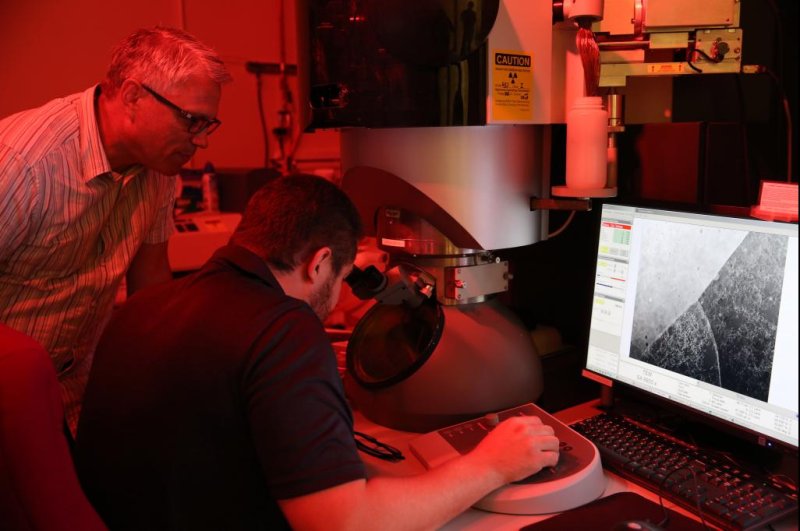LLNL materials scientist Joe McKeown stands next to postdoc researcher Thomas Voisin as he examines the microstructures in a sample of 3D printed stainless steel. Photo by Kate Hunts/LLNL
Oct. 31 (UPI) -- Scientists at Lawrence Livermore National Laboratory have developed a new technique for 3D-printing a low-carbon type of marine grade stainless steel called 316L.
Marine grade stainless steel is prized for its strength, durability and ductility. It's used for everything from nuclear waste storage facilities to kitchen appliances.
But until now, most methods for strengthening 316L and other forms of marine grade stainless steel have resulted in a sacrifice of ductility. The new method developed by scientists at LLNL -- and detailed this week in the journal Nature Materials -- requires no such sacrifice. Instead, the additive production process lends the material both high-strength and high-ductility properties.
"In order to make all the components you're trying to print useful, you need to have this material property at least the same as those made by traditional metallurgy," LLNL materials scientist Morris Wang said in a news release. "We were able to 3D-print real components in the lab with 316L stainless steel, and the material's performance was actually better than those made with the traditional approach. That's really a big jump. It makes additive manufacturing very attractive and fills a major gap."
The new production technology could prove a game-changer for the aerospace industry, which requires strong but lightweight metal alloys capable of withstanding extreme conditions.
Scientists at Lawrence Livermore developed computer models to help them figure out how to fuse metal powders during the 3D-printing process without introducing frailties into the material's microstructure.
"When you additively manufacture 316L it creates an interesting grain structure, sort of like a stained-glass window," said LLNL scientist Alex Hamza. "The grains are not very small, but the cellular structures and other defects inside the grains that are commonly seen in welding seem to be controlling the properties. This was the discovery. We didn't set out to make something better than traditional manufacturing; it just worked out that way."
Researchers believe their findings -- including an improved understanding of how the microstructures of 3D-printed materials affect their physical properties -- could be used to design all kinds of new and improved alloys and other materials.
"Deformation of metals is mainly controlled by how nanoscale defects move and interact in the microstructure," said LLNL postdoc researcher Thomas Voisin. "Interestingly, we found that this cellular structure acts such as a filter, allowing some defects to move freely and thus provide the necessary ductility while blocking some others to provide the strength. Observing these mechanisms and understanding their complexity now allows us to think of new ways to control the mechanical properties of these 3D-printed materials."















